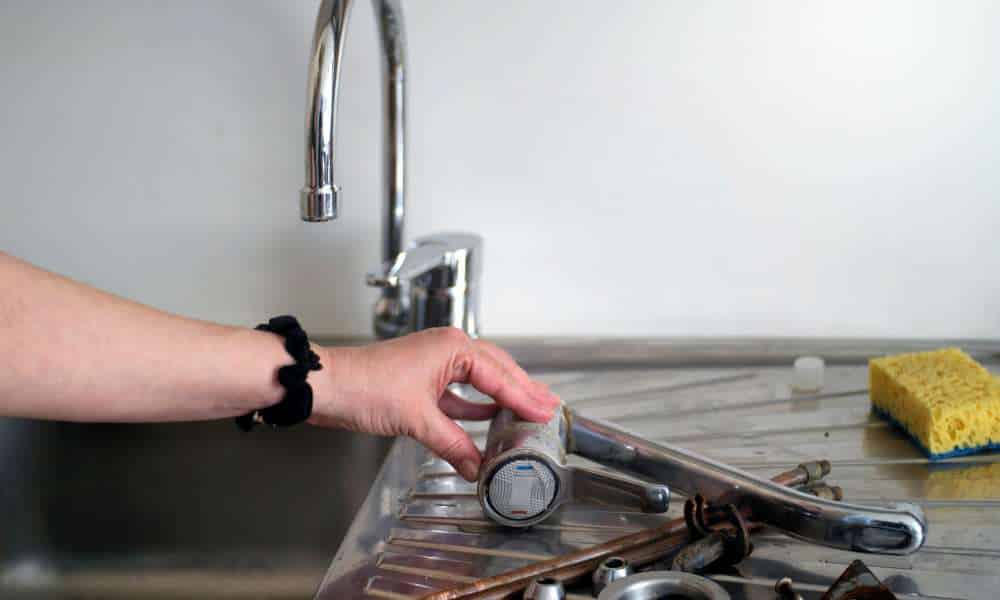Replacing a kitchen sink faucet is a straightforward home improvement project that can enhance both the functionality and aesthetic appeal of your kitchen space. Knowing how to replace a kitchen sink faucet allows you to update your sink with modern features or fix existing issues efficiently. By mastering this skill, you can save on plumbing costs and gain the satisfaction of completing a DIY task that significantly impacts daily kitchen activities. Whether you’re upgrading for style, fixing leaks, or improving water efficiency, understanding the steps involved and the importance of proper installation ensures a successful outcome. This guide will walk you through each stage, empowering you to confidently undertake and complete the process of replacing a kitchen sink faucet.
What Tools Do I Need To Replace A Kitchen Sink Faucet?

To replace a kitchen sink faucet, you will need a few basic tools to get the job done efficiently. Some essential tools include an adjustable wrench, pliers, a screwdriver (both flathead and Phillips), plumber’s tape, and a bucket or container to catch any water that may leak during the process. Additionally, having a flashlight can be helpful for better visibility in tight spaces under the sink.
How Long Does It Take To Replace A Kitchen Faucet?

Replacing a kitchen faucet typically takes around 1-2 hours for someone with basic plumbing skills. The process involves turning off the water supply, removing the old faucet, cleaning the area, and then installing the new faucet. It’s important to have the necessary tools on hand, such as an adjustable wrench and plumber’s tape, to ensure a smooth installation process.
Loosening Mounting Nuts
The first step is loosening the mounting nuts that secure the faucet to the sink. Using an adjustable wrench, carefully loosen these nuts beneath the sink counter. This action allows you to detach the old faucet from the sink easily, preparing the space for the new installation. Properly loosening these nuts avoids damaging the sink or plumbing fixtures, ensuring a smooth transition to the next phase of the replacement process.
Disconnecting Supply Lines
Disconnecting the supply lines from the old faucet is essential. Turn off the water supply valves located beneath the sink and use a wrench to disconnect the hot and cold water supply lines. This step prevents any potential leaks or water damage during the faucet replacement. It’s crucial to check for any residual water in the lines and drain them to avoid spills and ensure a tidy workspace. By disconnecting the supply lines carefully, you pave the way for installing the new faucet securely and efficiently.
Securing With Mounting Nuts
Securing the new faucet with mounting nuts is the final critical step in replacing a kitchen sink faucet. Position the new faucet in place on the sink deck and secure it underneath with mounting nuts. Tighten these nuts gently with your wrench, ensuring the faucet is stable and leak-free. This step not only ensures the proper functioning of the faucet but also contributes to the overall aesthetics of your kitchen sink area. Properly securing the faucet prevents wobbling or instability, providing peace of mind that your new fixture is securely installed and ready for use.
Positioning The New Faucet

Positioning the new faucet in your kitchen is a crucial step in upgrading the overall look and functionality of your space. When replacing a kitchen faucet, it’s essential to carefully consider the height and reach of the new fixture to ensure it aligns perfectly with your sink configuration. Opting for a high-arc or gooseneck design can provide ample space for washing large pots and pans effortlessly, while a pull-down spray head can enhance flexibility and convenience during meal preparation.
Attaching Best Supply Lines
Attaching the best supply lines is key to the faucet’s performance and longevity. Opt for high-quality, flexible supply lines that match the specifications of your new faucet. These lines should be securely connected to both the faucet and the water supply valves underneath the sink. Tighten connections carefully to prevent leaks, ensuring a steady flow of water without any disruptions. Properly attaching supply lines not only enhances the faucet’s functionality but also minimizes the risk of future maintenance issues.
Checking Functionality
Once the faucet is securely positioned and supply lines are attached, it’s crucial to check its functionality thoroughly. Turn on the water supply valves gradually and inspect for any leaks around the connections. Test both hot and cold water handles to ensure they operate smoothly and efficiently. Check the spray head (if applicable) for proper functionality and ease of use. Conducting these checks ensures that the new kitchen sink faucet is installed correctly and ready for everyday use, providing peace of mind and functionality in your kitchen space.
Flushing The Faucet

Flushing the faucet before installation is essential to remove any debris or sediments that may have accumulated during storage or shipping. This step ensures smooth operation and prevents potential blockages that could affect water flow. To flush the faucet, simply connect it temporarily to the water supply without mounting it permanently. Run both hot and cold water through the faucet for a few minutes to clear out any particles. This precautionary measure enhances the faucet’s longevity and maintains optimal performance from the moment it is installed.
Enhanced Functionality
Replacing a kitchen sink faucet not only updates the look of your kitchen but also enhances its functionality. Modern faucets often come with advanced features such as touchless operation, adjustable water flow settings, and enhanced durability. These improvements can make daily kitchen tasks more convenient and efficient, from washing dishes to filling pots with water. Choosing a faucet with these enhanced functionalities can transform your kitchen into a more user-friendly space, catering to your specific needs and preferences.
Water-Saving Features
Water-Saving Features are a crucial consideration when replacing a kitchen sink faucet. Modern faucets often come equipped with innovative technologies designed to reduce water consumption without compromising performance. Look for features such as aerators, which mix air with water to maintain pressure while using less water per minute. This not only helps conserve water but also lowers your utility bills over time, making it an environmentally friendly and cost-effective choice for your kitchen.
Budget-Friendly Options
Budget-Friendly Options abound when it comes to replacing a kitchen sink faucet. From basic models to high-end designs, there’s a faucet to fit every budget and style preference. Opting for a budget-friendly option doesn’t mean sacrificing quality. Many affordable faucets offer durability and functionality, backed by warranties for peace of mind. Compare different brands and models to find the best balance of price and features that meet your specific needs.
The Final Thought
Replacing a kitchen sink faucet is a manageable DIY project that can be completed with the right tools and guidance. By following the step-by-step instructions outlined in this article, you can easily upgrade your kitchen’s appearance and functionality. Remember to turn off the water supply before beginning the replacement process to avoid any mishaps. Take your time during each step to ensure proper installation and leak-free operation. With patience and attention to detail, you’ll have a new faucet installed in no time, transforming your kitchen into a more stylish and efficient space

